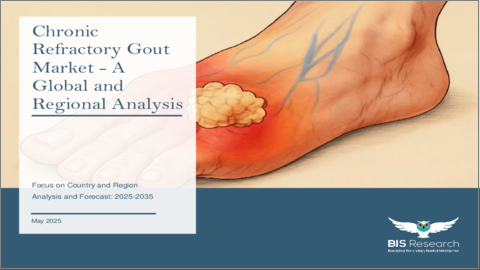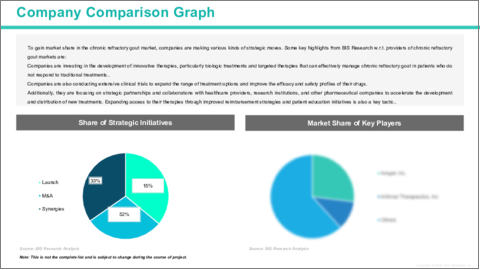|
|
市場調査レポート
商品コード
1734255
慢性難治性痛風の世界市場:地域・国別の分析・予測 (2025~2035年)Chronic Refractory Gout Market - A Global and Regional Analysis: Focus on Country and Region - Analysis and Forecast, 2025-2035 |
||||||
カスタマイズ可能
|
|||||||
| 慢性難治性痛風の世界市場:地域・国別の分析・予測 (2025~2035年) |
|
出版日: 2025年05月28日
発行: BIS Research
ページ情報: 英文 100 Pages
納期: 1~5営業日
|
全表示
- 概要
- 図表
- 目次
慢性難治性痛風市場の主な成長要因の一つは、痛風およびそれに関連するリスク要因の有病率の増加です。
世界的な高齢化が進み、肥満、高血圧、メタボリックシンドロームといった生活習慣病が増加する中で、慢性型や難治性を含む痛風の発症率も上昇しています。このような患者数の増加は、より効果的な治療法への需要を大きく生み出しています。また、既存の尿酸低下薬が効かない難治性ケースにおいては治療選択肢が限られていることから、生物学的製剤やその他の新しい治療法の開発が進められています。これらのことから、症状の管理や長期的な関節損傷の予防を求める患者のニーズにより、市場成長が促進されています。
一方で、慢性難治性痛風市場の成長には、いくつかの課題が存在し、その可能性を十分に引き出せない要因となっています。主な課題の一つは、ペグロチターゼ (Krystexxa) などの生物学的製剤の高額な治療費です。このような治療法は重度で難治性の痛風患者にとって不可欠ですが、非常に高価であり、多くの患者、特に低所得地域や保険の手厚くない人々にとっては利用が困難です。もう一つの課題は、長期的な治療計画における患者の服薬遵守です。多くの痛風治療薬、特に生物学的製剤は注射によって投与されるため、副作用、投与の煩雑さ、あるいは患者教育の不足によって治療の継続が困難になることがあります。
さらに、患者および医療提供者の双方における痛風管理に関する認識や教育の欠如は、誤診や治療の遅れの一因となり、難治性痛風の管理をさらに複雑にしています。加えて、痛風にしばしば併発する腎疾患などの合併症が治療計画を複雑にし、疾患の効果的な管理に対する障壁となっています。こうした課題に対応することが、患者の転帰改善と、新しい治療法への幅広いアクセスを実現するために不可欠です。
世界の慢性難治性痛風市場には、いくつかの重要な新興動向が見られます。中でも特に注目されるのは、生物学的製剤への関心の高まりです。ペグロチカーゼ (Krystexxa) などの生物学的製剤は、標的型の作用機序を持ち、重度かつ従来の治療に反応しない痛風の症例に対して高い治療効果を発揮することから、注目を集めています。これらの治療法は、モノクローナル抗体や酵素阻害剤などを含み、尿酸値の大幅な低下、痛風結節の改善、関節損傷の予防といった点で顕著な効果を示しており、慢性難治性痛風治療の中核を成す存在となりつつあります。より効果的な治療への需要が高まる中で、生物学的製剤は市場をリードすることが期待されており、次世代型バイオ医薬品に向けたさらなる革新と研究開発が促進されています。
当レポートでは、世界の慢性難治性痛風の市場を調査し、主要動向、市場影響因子の分析、法規制環境、臨床試験の動向、市場規模の推移・予測、各種区分・地域/主要国別の詳細分析、競合情勢、主要企業のプロファイルなどをまとめています。
目次
エグゼクティブサマリー
第1章 市場:業界展望
- 市場動向
- 規制の枠組み
- 疫学分析
- 臨床試験分析
- 市場力学
- 影響分析
- 市場促進要因
- 市場の課題
- 市場機会
第2章 世界の慢性難治性痛風市場:地域別
- 北米
- 欧州
- アジア太平洋
- 主な調査結果
- 市場力学
- 市場規模・予測
第3章 世界の慢性難治性痛風市場:競合情勢と企業プロファイル
- 主要戦略と開発
- M&A
- 相乗効果のある活動
- 事業拡大と資金調達
- 製品の発売と承認
- その他の活動
- 企業プロファイル
- Amgen Inc.
- Cartesian Therapeutics, Inc.
- Arthrosi Therapeutics, Inc.
- Shanton Pharma Holdings Limited
第4章 調査手法
List of Figures
- Figure: Global Chronic Refractory Gout Market (by Region), $Million, 2024 and 2035
- Figure: Global Chronic Refractory Gout Market Clinical Trial Analysis
- Figure: Global Chronic Refractory Gout Market Key Trends, Analysis
List of Tables
- Table: Global Chronic Refractory Gout Market, Epidemiology Analysis,
- Table: Global Chronic Refractory Gout Market Dynamics, Impact Analysis
- Table: Global Chronic Refractory Gout Market (by Region), $Million, 2024-2035
Global Chronic Refractory Gout Market, Analysis and Forecast: 2025-2035
Chronic refractory gout (CRG) is a severe form of gout, a type of arthritis caused by the accumulation of uric acid crystals in the joints. Unlike typical gout, where symptoms respond to standard treatments like NSAIDs or uric acid-lowering drugs, chronic refractory gout is characterized by persistent symptoms that do not improve with conventional therapies. This form of gout often leads to ongoing inflammation, intense pain, and the development of tophi-large deposits of uric acid crystals that form under the skin and around joints.
The condition is challenging to manage, particularly when factors such as non-compliance, inadequate drug response, or co-existing conditions like kidney disease or obesity contribute to its persistence. Treatments for chronic refractory gout include biologic therapies such as pegloticase (Krystexxa), which helps lower uric acid levels in the blood, and other emerging drugs aimed at reducing flare-ups and improving quality of life. While the condition can cause significant joint damage if left untreated, the advent of new treatments offers hope for better management and symptom control in affected individuals.
One of the key drivers of the chronic refractory gout market is the rising prevalence of gout and associated risk factors. As the global population ages and lifestyle-related conditions such as obesity, hypertension, and metabolic syndrome become more prevalent, the incidence of gout, including its chronic and refractory forms, has been increasing. This growing patient population creates a significant demand for more effective treatments. Additionally, the limitations of existing therapies in managing refractory cases, which do not respond to traditional uric acid-lowering medications, have spurred the development of advanced biologics and other novel therapeutic options. This, in turn, drives market growth as patients seek better management options to control symptoms and prevent long-term joint damage.
Despite the growth of the chronic refractory gout market, several challenges persist that can hinder its full potential. One major challenge is the high cost of biologic therapies like pegloticase (Krystexxa), which are essential for treating severe, refractory cases of gout. These treatments can be prohibitively expensive, limiting access for many patients, especially in lower-income regions or for those without comprehensive insurance coverage. Another challenge is patient adherence to long-term treatment regimens. Many gout medications, particularly biologics, are administered via injections, which may lead to non-compliance due to side effects, administration complexity, or a lack of patient education.
Additionally, the lack of awareness and education about gout management among both patients and healthcare providers can contribute to misdiagnosis or delayed treatment, further complicating the management of refractory gout. Furthermore, co-morbid conditions such as kidney disease, which often accompany gout, complicate treatment plans and create additional barriers to achieving effective control of the disease. Addressing these challenges is essential for improving patient outcomes and ensuring broader access to emerging therapies in the chronic refractory gout market.
The global chronic refractory gout market is highly competitive, with several major companies actively involved, including Amgen Inc., Cartesian Therapeutics Inc., Arthrosi Therapeutics Inc., and Shanton Pharma Holdings Limited. These companies are at the forefront of developing and commercializing therapies aimed at addressing the unmet needs in managing chronic refractory gout, with a focus on innovative biologics, novel drug formulations, and targeted treatments to improve patient outcomes in this challenging condition.
The global chronic refractory gout market is experiencing several key emerging trends. One significant trend is the increased focus on biologic therapies. Biologics like pegloticase (Krystexxa) are gaining traction due to their targeted mechanism of action and ability to effectively treat severe, treatment-resistant cases of gout. These therapies, which include monoclonal antibodies and enzyme inhibitors, are becoming the cornerstone of chronic refractory gout treatment, offering substantial improvements in reducing uric acid levels, alleviating tophi, and preventing joint damage. As the demand for more effective treatments grows, biologics are expected to dominate the market, driving further innovation and research into next-generation biologic therapies.
Table of Contents
Executive Summary
Scope and Definition
Market/Product Definition
Inclusion and Exclusion
Key Questions Answered
Analysis and Forecast Note
1. Markets: Industry Outlook
- 1.1 Introduction
- 1.2 Market Trends
- 1.3 Regulatory Framework
- 1.4 Epidemiology Analysis
- 1.5 Clinical Trial Analysis
- 1.6 Market Dynamics
- 1.6.1 Impact Analysis
- 1.6.2 Market Drivers
- 1.6.3 Market Challenges
- 1.6.4 Market Opportunities
2. Global Chronic Refractory Gout Market (Region), ($Million), 2023-2035
- 2.1 North America
- 2.1.1 Key Findings
- 2.1.2 Market Dynamics
- 2.1.3 Market Sizing and Forecast
- 2.1.3.1 North America Chronic Refractory Gout Market, by Country
- 2.1.3.1.1 U.S.
- 2.1.3.1.2 Canada
- 2.1.3.1 North America Chronic Refractory Gout Market, by Country
- 2.2 Europe
- 2.2.1 Key Findings
- 2.2.2 Market Dynamics
- 2.2.3 Market Sizing and Forecast
- 2.2.3.1 Europe Chronic Refractory Gout Market, by Country
- 2.2.3.1.1 Germany
- 2.2.3.1.2 U.K.
- 2.2.3.1.3 France
- 2.2.3.1.4 Italy
- 2.2.3.1 Europe Chronic Refractory Gout Market, by Country
- 2.3 Asia Pacific
- 2.3.1 Key Findings
- 2.3.2 Market Dynamics
- 2.3.3 Market Sizing and Forecast
- 2.3.3.1 Asia Pacific Chronic Refractory Gout Market, by Country
- 2.3.3.1.1 Japan
- 2.3.3.1 Asia Pacific Chronic Refractory Gout Market, by Country
3. Global Chronic Refractory Gout Market: Competitive Landscape and Company Profiles
- 3.1 Key Strategies and Development
- 3.1.1 Mergers and Acquisitions
- 3.1.2 Synergistic Activities
- 3.1.3 Business Expansions and Funding
- 3.1.4 Product Launches and Approvals
- 3.1.5 Other Activities
- 3.2 Company Profiles
- 3.2.1 Amgen Inc.
- 3.2.1.1 Overview
- 3.2.1.2 Top Products / Product Portfolio
- 3.2.1.3 Top Competitors
- 3.2.1.4 Target Customers/End-Users
- 3.2.1.5 Key Personnel
- 3.2.1.6 Analyst View
- 3.2.2 Cartesian Therapeutics, Inc.
- 3.2.2.1 Overview
- 3.2.2.2 Top Products / Product Portfolio
- 3.2.2.3 Top Competitors
- 3.2.2.4 Target Customers/End-Users
- 3.2.2.5 Key Personnel
- 3.2.2.6 Analyst View
- 3.2.3 Arthrosi Therapeutics, Inc.
- 3.2.3.1 Overview
- 3.2.3.2 Top Products / Product Portfolio
- 3.2.3.3 Top Competitors
- 3.2.3.4 Target Customers/End-Users
- 3.2.3.5 Key Personnel
- 3.2.3.6 Analyst View
- 3.2.4 Shanton Pharma Holdings Limited
- 3.2.4.1 Overview
- 3.2.4.2 Top Products / Product Portfolio
- 3.2.4.3 Top Competitors
- 3.2.4.4 Target Customers/End-Users
- 3.2.4.5 Key Personnel
- 3.2.4.6 Analyst View
- 3.2.1 Amgen Inc.






